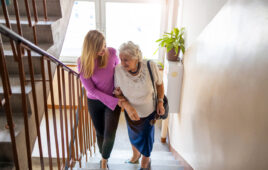As people age and life happens, a dream home can quickly lose some of its appeal. But making minor adjustments, or in some cases, having a home completely remodeled, can allow a person to stay where the heart is.
Dan Bawden, president of Legal Eagle Contractors, who is also a Certified Aging in Place Specialist (CAPS), Graduate Master Builder (GMR) and Certified Graduate Remodeler (CGR), refers to making a home more accessible as “grand design” that ensures the dwelling is as practical for the grandparents as it is for their grandchildren. Here are some key things to keep in mind:
Consider multiple height kitchen counters. Providing different kitchen counter levels ensures it is useful for someone in a wheelchair as well as someone who’s not, Bawden explains. It also is suitable for the grandkids to participate in some cooking adventures, Bawden added.
Keep design in mind. There are many steps to take to make a home more accessible without losing beauty or value. To help them do that, Bawden stresses that DMEs who sell home accessibility equipment and contractors should take the CAPS training course. The three-day course teaches dealers and contractors how to communicate effectively with members of the accessible market and elderly community along with design and building solutions for aging and accessibility.
“All of this centers around a strong desire for people to stay at home,” he says. “They want to be in the familiar patterns and family celebrations of life. They know where the grocery store is and where the church and synagogue are so the alternative that they’re trying to avoid is going to an assisted-living or a nursing home.”
Add visual cues. Making a home accessible is not just limited to adding grab bars, and lever handles on faucets and door knobs. It also includes contrasting colors and lighting. For instance, Bawden likes to use a different color on countertops and cabinets in the kitchen and bathroom so the countertop height can be determined. For stairs, he prefers to paint the risers of wooden stairs black or white, while either staining the tread or leaving it a wooden color. This helps the homeowner’s depth perception when going up the stairs.
Remove steps for universal appeal. One of the biggest obstacles new wheel chair users and people with other accessibility issues face is porches or steps. A remedy is adding a slope that comes in from the driveway all the way up to the entry (either back or front). In keeping with the universal design theme, not only is the slope great for someone in a wheelchair, but also for a mom trying to bring her twins into the home with a stroller. Inside the home, doorways are often 24-inches wide, making it harder to gain entry. Widening doors and hallways can improve accessibility.
Upgrade the bathroom. The bathroom is usually an area that gives people accessibility problems. Add comfort height toilets, drawers instead of cabinet doors, non-slip floor material and curbless showers to help those with accessibility issues get around more easily.
Encourage easy movement. In the bedroom and living room areas, furniture should be spaced so people can navigate throughout the home easily. Specialized furniture such as lift chairs also helps. Contractors are beginning to collaborate more with DME providers for equipment such as lift chairs, portable grab bars and whirlpool tubs with battery operated chairs that lift people out of the water.
Many people are unable to get a wheelchair or walker into tight spaces such as closets.Consider using doors that slide to the side and fold into the wall.
Create a downstairs bedroom. One of the most common remodeling projects is having a room downstairs converted into a bedroom, since many older homes have bedrooms located upstairs with a half bathroom located under the stairs. The half bathroom can be turned into a full bath.
Consider an elevator. Elevators can become essential, but they are hard to retrofit. Today, smart builders are designing homes with stacked closets that can be turned into an elevator. If this doesn’t exist, contractors sometimes can build an elevator outside of the home.
Partner with other pros. One of the main goals in making a home more accessible is making it fit the client’s needs. Therefore, it’s important to form partnerships with medical professionals to ensure that the changes being made are right for the end-user.
Points to take away:
• Take the CAPS course; call the National Association of Home Builders at (800) 368-5242 ext. 0 to learn more
• Use contrasting colors
• Lower lights and add different height counter tops to universalize the home.
• Have a room downstairs that can be converted into a bedroom
• Space furniture out to allow for easy navigation
• Collaborate with medical professionals to get a better understanding on the progression of diseases and different disabilities

